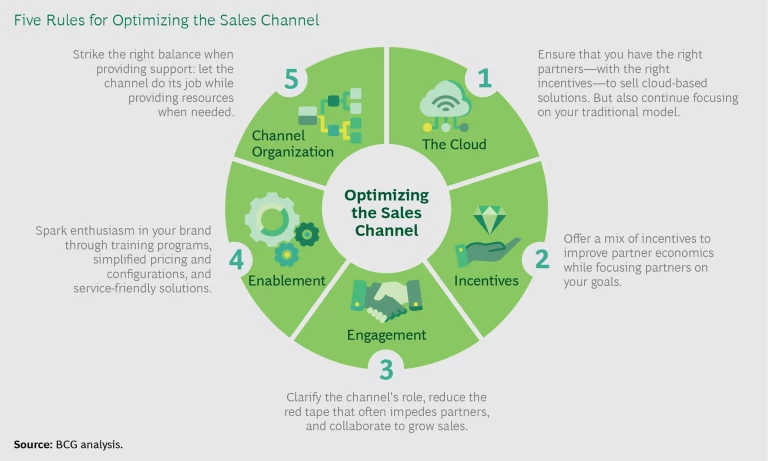Technology manufacturers have long known that an indirect sales channel can be a pretty direct route to growth. Distributors and resellers typically drive 70% or more of a tech vendor’s revenue—a huge number but perhaps not a surprising one. Channel partners provide easier access to the fast-growing small and midsize business segment. They help vendors expand into new geographies without requiring big on-the-ground investments. They boost a product’s appeal by grouping it with complementary offerings. And, of course, they put so many more promoters, proponents, and evangelists for a vendor’s wares out in the field.
All of this is well and good. But in this case, leaving well enough alone is a mistake. The technology business—and the channel itself—is undergoing unprecedented shifts. End users increasingly want to procure their technology “as a service” instead of as a one-time purchase. Acquisitions are rapidly consolidating channel players. New technologies are giving distributors and resellers more choice in what they sell.
To keep channel sales growing, many vendors will need to rethink the way they work with and offer incentives to their partners—both traditional collaborators like resellers, distributors, and independent software vendors and next-generation partners like cloud service providers and telcos. This is no small undertaking, but vendors who master five key rules can optimize the sales channel. (See the exhibit.)
Embrace “As a Service” but Don’t Abandon the Traditional Model
The rise of cloud-based services—for everything from software applications to infrastructure—has revolutionized the way technology is designed, sold, and used. Instead of paying for a product upfront, an end user will make smaller payments on an ongoing, subscription basis. While some vendors—including major software players like Adobe and Microsoft—initially viewed this “as a service” model as a new way to sell direct, most ultimately discovered that the channel is critical here, as well. Many buyers—small and midsize businesses, in particular—prefer purchasing all of their technology from a single source. They often leverage the financing and support options that resellers offer. And they expect in-depth sales conversations linking technology to business impact, which is the channel’s forte.
But “cloudifying” the channel raises some unique challenges. Vendors must ensure that their partners have the ability—and incentive—to sell a cloud-based solution. At the same time, most vendors will still need to keep traditional offerings available—and moving. That’s because in some situations—such as when end users have predictable IT capacity needs or a consistent baseload—it can be less expensive to use on-premises solutions (or to use cloud solutions for only the variable component above the baseload). Indeed, even as cloud sales rise, the market for traditional offerings is still growing. This means that tech vendors need to capture—and quickly expand—as-a-service revenues while still supporting the traditional model.
So how do savvy vendors do this? In our experience, a three-pronged approach can set the stage:
- Easy-to-Sell Solutions. Distributors and resellers will follow the path of least resistance. So vendors need to make the sales process as simple as possible. This means understanding that channel partners will be selling cloud solutions from multiple vendors, and the most efficient way to do that is from a single platform. Vendors, then, will want to make their offerings available on the most popular hosting platforms, such as Amazon Web Services, AppDirect, and Odin. Seamlessly integrating a solution with a third-party platform can be difficult, but it’s important to put in the work. Simplified pricing options also are essential. Vendors should consider monthly, annual, and consumption-based billing. Another best practice: offering an entry-level solution upon which the user can add—as needed—more features and functionality over time.
- “Born in the Cloud” Channel Partners. For all the growth and activity surrounding cloud-based solutions, we’ve found that only 10% to 15% of traditional resellers will actually invest and become successful in building a cloud business. This isn’t totally surprising, given that provisioning and administering a cloud solution requires new capabilities. But such a smaller subset has two key consequences. First, vendors will need to identify those existing resellers who are best poised to make the jump to the cloud. One way is to partner with distributors to perform predictive analytics on transaction data. The idea: look at reseller purchasing history to focus on those most likely to embrace and promote cloud offerings. For example, a reseller that sells a lot of servers has a higher propensity for the cloud than one that sells a lot of laptops.
Second and more important, vendors will need to find new partners to achieve their cloud business goals. A cloud-ready base comprising 10% to 15% of existing partners is insufficient to fully capture the as-a-service opportunity. To fill the gap, vendors can turn to a new breed of channel players: cloud service providers (CSPs) or managed service providers (MSPs), who came into being with the cloud and focus exclusively on as-a-service offerings. Already, CSPs and MSPs deliver more than half of channel-based cloud revenue. Targeted recruiting programs—potentially in partnership with larger distributors, hosting platforms, and even complementary vendors—can help woo these “born in the cloud” resellers.
- A Balance Between Cloud and Traditional Incentives. Performance incentives can be a powerful way to spur channel partners to embrace the as-a-service model, invest in the required capabilities, and promote subscription-based offerings. But that doesn’t mean every vendor will succeed with a Microsoft-like approach, tying the bulk of their incentives to cloud growth. Indeed, unless vendors expect a complete market shift to the cloud—and most shouldn’t—they’ll be better served by gradually shifting incentives to cloud solutions. We recommend initially moving 10% to 20% of incentive dollars to cloud solutions and increasing that figure over time. The idea is to keep channel partners focused on what will be, at least for the midterm, most vendors’ core business, while also planting the seeds to grow the cloud model.
Another consideration is what, exactly, makes for a cloud-friendly incentive. Since upfront revenue is limited, cloud partners are unlikely to find a traditional revenue-based incentive appealing. Instead, incentives should be tied to different metrics such as new-subscriber acquisitions and utilization. Indeed, utilization is a particularly important KPI for models like the cloud, which depend on recurring revenue. If customers aren’t using a particular solution, they aren’t likely to keep paying those monthly fees. So vendors and channel partners need to ensure that there is a plan for tracking—and sustaining—utilization.
Optimize the Overall Incentives Strategy
Balancing cloud and traditional incentives is crucial, but it’s just one component of a smart incentives strategy. Consolidation within the channel is increasing the power—and bargaining position—of larger distributors and resellers. Big players can be choosers, and they’re going to go with vendors that bring them the strongest returns. Vendors should carefully consider the economics of their partners and develop a formula that gets the channel’s attention. Early-pay discounts, back-end rebates, business development and marketing funds, as well as ad hoc investments with the channel partner are all useful here. HP, for example, offers early-pay discounts, among other incentives, to sweeten the pot in a lower-margin category.
At the same time, vendors should leverage incentives to focus the channel on strategic goals. Tech companies know where they want to take their business—growing a specific market or customer segment, for example—but they need to make their priority the channel’s priority.
A savvy mix of incentives, then, furthers partner economics while setting partners in a specific direction. Many vendors will likely need to adjust their existing incentive programs to get the mix right, but in doing so, they can choose from an array of levers. They can include things like an extra rebate on sales to targeted customer segments, incentives for attaining certain technical certifications, incentives to penetrate a market with a new solution, or rebates for attaching services at a specific level.
As powerful as they can be, incentives aren’t a panacea. Occasionally vendors will need to consider when some tough love is required. A performance improvement program (PIP) can be an effective mechanism for driving results from a lagging distributor, but many vendors wait too long before taking action. The key is to have clear thresholds and timelines. For example, if a distributor does not achieve quotas for two quarters, this should trigger a PIP. Developed by the distributor, the plan should have appropriate goals, actions, and metrics to reach acceptable levels. A good rule of thumb is to require tangible, quantifiable improvement within three to six months.
Modernize Relationships with Channel Partners
While the right incentives can go a long way to ensure commitment from the channel, vendors need to take additional steps to strengthen relations with their partners. The key is to eliminate the ambiguities and burdens that often hold back channel partners, while teaming up to grow customer lists and sales. This combination of clarity, convenience, and collaboration can be a powerful way to focus the channel on selling—and finding ways to sell more of—your products. In our experience, best practices include:
- Clarity on Direct Versus Indirect Sales. Resellers and distributors want to know that demand they generate will not end up becoming a direct deal. Sales partners are unlikely to devote much time and resources to short-lived customers, and they’ll gravitate to vendors who don’t decide to take business direct when convenient. It’s crucial, then, to avoid even the prospect of unwelcome surprises, and one way to do that is to create a list, or so-called hard deck, of customers that can be sold to direct. This erases all ambiguity. If a customer is not on the list, it’s an indirect-sales customer. Period.
- Senior Executive Commitment to the Channel. When CEOs spend time with the channel and solicit feedback—via road shows, partner advisory councils, and vendor events—they sow confidence in the vendor’s commitment to its indirect sales partners. Michael Dell and Cisco’s Chuck Robbins are frequently—and prominently—visible within the channel. Other CEOs should consider following their example.
- Leveraging Partner Data—in Joint Efforts. Channel partners possess a wealth of data—often much more than a given vendor—on what customers buy and how they use products. By working with partners to access and analyze this information, vendors can better identify demand (for both new and existing products); spot opportunities for technology refreshes, up-selling, and cross-selling; and understand the propensity for cloud adoption, among other things. VMWare, for example, has used propensity studies to target marketing efforts, and that has helped accelerate growth. Such collaboration strengthens relationships between vendors and partners while bringing tangible benefits for both.
- Minimal Administrative Burdens. Streamlined processes—for activities like authorizations, price exceptions, and discount and rebate claims—can simplify a lot of the “back office” tasks for partners. The less complex a vendor makes life for a partner, the more likely that partner is to focus on the vendor.
Focus, of course, is a two-way street. As vendors modernize their channel relationships, they also should zero in on distributors that can best help them scale. Here, the consolidation among distributors can work to a vendor’s advantage. If a tech company can get the same—or greater—coverage working with fewer, but stronger, distributors, it doesn’t have to spread its resources supporting many smaller players. At the same time, it can give each distributor a larger share of its business, providing each with an incentive to invest in the relationship. In fact, in the RFP process, savvy vendors will ask distributors what actions they are willing to take to gain more of the vendor’s business. Approached in this manner, consolidation can be a win for both vendors and distributors.
Strengthen Channel Enablement Capabilities
Many vendors will underemphasize—or overlook entirely—opportunities to spark enthusiasm in the brand. Fortunately, there are proven ways vendors can set up their partners for success:
- Strong Channel Training Programs. Channel partners talk to end users—sometimes thousands of them—daily. While financial incentives can be powerful motivators in promoting one brand over another, so, too, can simple familiarity with a product. The idea is to create comprehensive—but not burdensome—training programs for partner sales and technical teams. By doing so, vendors can ensure that partners know the ins and outs of the brand and will readily see when it’s a good fit for a customer.
- Simplified Pricing and Configurations. Channel partners will gravitate to products that can be explained to customers in a compelling elevator pitch—not a 50-page synopsis. It’s all about making it easy for partners to sell a solution. Some good ways to do that: offer basic solutions with upgrade options; provide both “velocity” SKUs (popular configurations that distributors can stock en masse) and special configurations (which can be stocked in smaller quantities or special ordered); expedite special pricing requests (ideally responding within two to four hours); and ensure prompt delivery and support.
- Easy-to-Attach Solutions. Smaller and midsize vendors can often make their products easier to sell—while gaining visibility in the channel—by attaching them to complementary offerings from more established vendors. Veeam, for example, become a top-selling player in the backup-and-recovery space within a few years of positioning its solution as an easy attach to VMWare.
- Service-Friendly Solutions. Channel partners generate a significant portion of their profit from services such as installation, monitoring, and maintenance. The easier vendors make it to attach these services to their solution, the more likely they are to catch a partner’s eye—and focus. Things can get tricky, however, when a vendor itself provides similar services. Vendors can demonstrate their commitment to the channel—and ultimately boost results for themselves and their partners—by making it clear that channel services will be a priority and allowing partners to attach overlapping services where appropriate. Another good practice is thoughtful use of vendor warranty services, which provide partners with additional profit since the margins tend to be relatively high. But vendors can go one step further, making it clear when partner services for maintenance or monitoring can be incorporated into the vendor’s offering.
Reassess the Channel Support Organization
Finally, vendors should examine—and likely adjust—their channel support organization. While streamlining administrative processes can go a long way in keeping partners focused on sales, there is a lot more that goes into a transaction—particularly when it comes to larger deals. Partners may need to call on the vendor for product demos, technical support, and pricing assistance, among other things. Providing these resources may seem straightforward, but in practice, most vendors either provide too little support—effectively starving their channel support teams—or they overinvest, raising costs and blurring the line between supporting a partner’s sales and micromanaging them.
So how can vendors strike the right balance? The first step is to define the appropriate coverage for each channel partner. Large distributors and resellers typically require dedicated resources, while smaller partners can be supported by shared, territory-wide teams, in conjunction with distributor resources. Costs should be lower for indirect sales than for direct sales, but resources—and the outlays for them—should be appropriate to support the revenue opportunity.
Next, vendors need to ensure that the channel has sufficient autonomy. That means avoiding the temptation to shepherd every large deal and ask for updates every few days. Striking the right balance between support and interference is a delicate business, but some vendors have learned how to do it well. Cisco, for example, is very good at supporting the channel more on larger opportunities and end users, while allowing partners to run with the SMB and most midmarket business. The idea is to let the channel do its job while being available—when needed—to support a transaction. The result is more committed channel partners and a better cost structure.
As vendors cast their eyes to their own organization, they should also ensure “channel neutrality” for their field reps. Reps can often sway how deals are fulfilled, and if channel partners feel that a field rep has a bias for moving deals direct, they will avoid that rep—or worse, work with another vendor. Some vendors incorporate a three strikes rule, terminating a field rep who repeatedly violates the company’s channel neutrality policy. Of course, the best scenario is to avoid those violations in the first place. One way to do that: compensate field reps equally whether a deal is filled direct or through the channel.
The channel has long been a reliable way for technology vendors to grow sales, market share, and reach. But maintaining that success means not maintaining the status quo. As technologies—and end-user preferences—evolve, vendors need to make the right changes in how they enable and support their channel partners and what incentives they offer. By optimizing the channel, vendors not only keep up with the rapid shifts in the industry but they also prosper from them.







